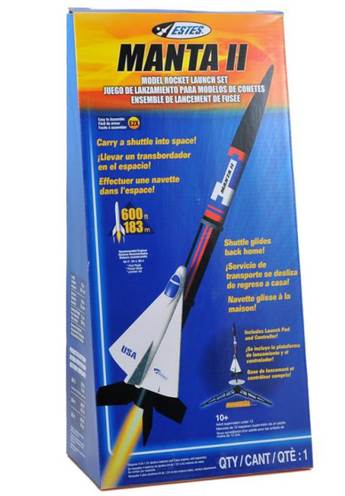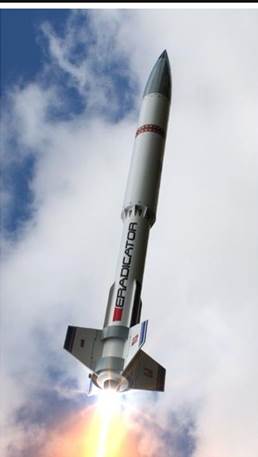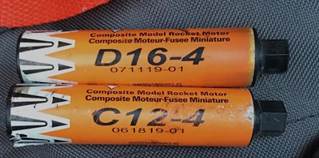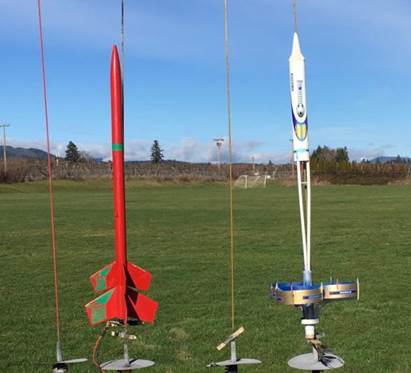The British Broadcasting Corporation (BBC) did a great documentary in preparation for the Apollo 11 50th anniversary last year which was really well done. For those rocket history buffs, they may find this interesting:
Month: February 2020
F Powered Boost Glider
Here is a cool kit to build and try:
J&H Aerospace makes some really interesting boost gliders that are ideal for NAR Contests: https://jhaerospace.com/
Common Causes for a Rocket to Fail
This table contains information about the most common causes for a rocket to fail.
The intent is that, with proper care and prevention, these failure modes may be avoided. (Source From NASA Houston Rocket Club NAR Section 365)
| TASK/STEP | HAZARD | CAUSE | PREVENTATIVE MEASURE |
| Any | 1. Non-Hazardous Anomaly | Premature parachute ejection | All flights in this category result in safe landing under parachute. – |
| Flight preparations | 2. Premature motor ignition | Connecting igniter to live ignition system | – Using systems with a switch that returns to “off” when released per NAR safety code. Ensure continuity checker is igniter/electric match/flash bulb safe. |
| 3. Premature ejection charge ignition | Electronic Altimeter failure / capacitor discharge | -use switch or shunt on charge circuits until placed on pad | |
| Rocket boost | 4. Erratic boost | a. Rocket unstable | – Check the stability of the rocket with the selected motor per NAR safety code if not a proven design/motor combination -Use computer CG/CP program, CP should be 1.0 body diameter aft of CG |
| b. Unstable launch pad | – insure launch pad is sufficiently strong to withstand wind and launch forces. – use rail system for HPR launches | ||
| c. Too much wind | – Launch only in winds of less than 20 mph as required by NAR safety code – In windy conditions low thrust launches should be avoided. | ||
| d. Insufficient thrust | – Follow anufacturer¹s recommended maximum lift-off weight per NAR safety code – Use computer simulation program to determine thrust required | ||
| 5. Airframe failure | a. Improper construction | – Follow manufacturer assembly instructions. – On original designs use standard construction methods. – Check for secure fins, launch lugs, and proper nose cone fit. – Check secure motor mount assembly. | |
| b. Fin flutter | – Be sure to align grain with leading edge of fin. (standard construction method) – Avoid high aspect ratio fins | ||
| c. Improper Motor Selection | – Use care in selecting motor for flight. Follow manufacturer recommendations. – Follow manufacturer recommendations for max lift off weight per safety code. – Attempt high-G launches only rockets having appropriate construction. | ||
| 6. Catastrophic motor failure | a.Temperature cycling of black powder motors | – Store motors at a consistent temperature | |
| b. Improper construction | – Check all parts have been used (O-rings, ejection charge, spacers, etc.) – Check closures are tight, threads are not stripped. | ||
| Rocket recovery | 7. Failure to eject recovery system | a. Motor ejects from rocket | – Use motor retainer clips or sufficient tape to provide positive friction fit of motor – Be sure that recovery system not packed too tightly – Use heat resistant adhesives in motor retention system |
| b. Improper assembly of reloadable motors | – Build motor correctly following manufacturer directions – Avoid grease on delay element – Avoid crimping or damaging o-rings -Verify ejection port is clean and clear – Insure ejection charges are loaded | ||
| c. Electronics failure | – Verify system integrity before first flight or after major changes – Use motor ejection for redundancy | ||
| d. Failure of electronic recovery system to fire ejection charge | – Verify charge integrity with multi-tester or self-testing recovery system – Check mach lock-out settings on altimeter – Insure all hardware and electrical leads are installed properly and secured against flight loads. | ||
| e. Construction/ Preparation | – Too much wadding/packed too tightly – parachute packed too tightly – obstructions within body tube | ||
| TASK/STEP | HAZARD | CAUSE | PREVENTATIVE MEASURE |
| 8. Failure of chute to open | a. Recovery device stuck in rocket body | 1- Too much wadding 2- Recovery device too large or not packed properly 3- Insufficient ejection charge for size of body tube – see chart | |
| b. Parachute burned by ejection gasses | – Use flame-resistant recovery wadding or other protection system | ||
| c. Parachute shroud lines fouled | – Fold parachute carefully as described by manufacturer | ||
| 9. Strip of recovery system at deployment | a. Deployment occurred too early or too late | – Follow anufacturer¹s recommended maximum lift-off weight and/or computer simulation data. – Use electronic apogee detecting deployment system. – Use rocket flight simulation program to simulate flight determine best delay time. – Select shorter delays when winds are higher. The rocket will weather vane into the wind and shorter delays are required for proper recovery system activation. | |
| b. Improper construction | – Use proper hardware | ||
| 10. Separation of recovery or other system. | a. Recovery system improperly secured during preflight prep. | – For initial flight, or subsequent flights after repair, double check that the recovery system is properly attached to the rocket/payload section/nose cone. Inspect quick links, eyebolts, or other hardware to ensure that links are closed/locked and that other hardware is intact and secured. – Insure eye bolt connector will not un-screw during descent | |
| b. Failure due to wear and tear of flight operations | – Periodically inspect all components of the recovery system. Replace/repair burned or worn shock cords. Replace/repair parachutes with worn or frayed shroud lines. | ||
| 11. Rocket drifts into buildings / houses / trees | a. Parachute too large | Refer to parachute sizing guide and drift charts on back of checklist | |
| b. Too windy | Insure winds are within limits. Consider winds aloft information | ||
| c. Main parachute deploys early | -Use shear pins to secure main parachute compartment. -Use extra long shock cord and “metered deployment” of cord in drogue section. -Use proper amount of black powder in drogue ejection charge | ||
| 12. Rocket impacts prep area causing personal injury | Spectators not paying attention to rocket flight | – Use electronic PA system for all high power launches. – Launch Control Officer responsible for calling “Heads Up” -LCO give periodic detailed briefing to spectators on the meaning of ‘heads up’ and the corrective action to be taken -If possible, angle all flights away from spectators | |
| 13. Rocket impacts Buildings/houses in ballistic flight | Multiple failures | -Follow wind/altitude restrictions – see “failure to eject recovery system” |
NOTE: Preventative measure is not all inclusive and additional precautions may be required in order to maximize safe flying condition.
February 9th 2020 GRC 790 Launch Report
The weather turned out really very nice for a club launch for February 9th 2020 at the WyEast Middle School

Vernon, Don and John Casey were in attendance along with me for the launch. It was sunny with little to no wind. The field was quite marshy, so the pad was set up on the pitcher’s mound since that was the highest and driest spot out in the field. John Casey launched a very cool model rocket from Estes called the Manta II.
It may be a discontinued kit, however Estes is offering starter kit called the Javelin which looks very similar: https://estesrockets.com/product/001436-javelin-launch-set/
The rocket was launched as least four times on Sunday and each time the little glider stayed up in the air for more than 30 seconds each flight and was really impressive to watch fly.
This kit would be ideal for anyone wanting to try for the NARTEK Silver patch: https://www.nar.org/wp-content/uploads/2014/08/NTSilver.pdf
The NARTREK program is a great skills achievement program. They offer the Bronze, Silver and Gold Achievement and advanced programs: https://www.nar.org/members/nartek-skills-program/

Don Buchanan Launched the Estes Multi-Roc Rocket once with the boost glider attached and twice in the two stage configuration without the boost glider. The booster sections parachute caused the rocket to land up behind the baseball catchers mount fence. Before we knew it, Vernon was climbing up the fence and retrieved the booster section which was used again for two more flights as a two stage rocket. All flights were very impressive and successful. Then he launched the Sirius Rocketry Eradicator rocket: https://www.siriusrocketry.biz/ishop/sirius-rocketry-eradicator-29mm-1332.html
The First launched was on an Estes E motor which was a slow liftoff and achieved an altitude of less than 200 feet. He made up for it on the second flight with an Aerotech Economax F-67-4 https://www.rocketryworks.com/f67-4/?gclid=Cj0KCQiAm4TyBRDgARIsAOU75sqjFEguDZi7O6XuxNIGOZLM33xtuExu3vWbbVtuKOlWWF6XL58QLKoaAiodEALw_wcB which kicked that rocket up to 600 plus feet. Don had a Jolly Logic Alt 2 in the rocket so it provided data for speed (max speed was 192 miles per hour with close to a max g force of 10 gs).
That was the highest impulse launch of the morning. J
I launched four very light weight rockets from Discount Rocketry that were called Nexus rockets: https://www.discountrocketry.com/advanced_search_result.php?keywords=nexus&sort=4a they are pretty cool because they require assembly without any glue. They can easily go up to 1000 feet with an Estes C6-5 motor.
I launched two with Estes motors and then two more with the new Quest Aerospace C and D composite motors:


I was not impressed and honestly embarrassed and disappointed as to how the C and D motor under performed. Both motors sputtered on the pad and then caused the rocket to lift off and do a U-turn into the muddy ground. It was funny to see that happen, however if this had happened to a new rocket hobby enthusiast with a complex model they had spent hours on, hoping that the motor would push the rocket high up in the air like the Estes C and D motors normally do, then that would have been very bad and sad. Fortunately you as a hobby consumer can do something about it. First, retain the motor and take a photo like the one above that has the motors lot/batch number. Go to this web site: http://www.motorcato.org/ There is a link to report a motor malfunction. There is also a list to review of the most recent motor issues here: http://www.motorcato.org/latest

Sometime it may be a good idea to see what others have reported about a certain motor before buying it. Also sometimes you can email to the motor vendor such as Aerotech or Estes and they may try to compensate you with a new kit or new motors if the motor burned through the side of your rocket.
Towards the end of the launch window, I launched a FlisKits model rocket called the Borealis. It is a very cool looking Sci-Fi kit that I do hope the new owners bring back for further sales. It looks complicated, however can be built within two days. It was launched up into the sky with an Estes C6-3. The rocket lifted up perfectly and the rocket rotated while under thrust slowly as if it was going to be placed in orbit. The recovery parachute did not deploy perfectly, however the model is so light weight that the landing was fine and the rocket suffered no damage at all.
Next Sunday February 16th is our launch at Goldendale. I do hope the weather turns out nice like the launch we just had here at Wy East. Keep your fingers and toes crossed. I will see you all there.
“May the winds be light, and the skies be blue, and may all your rockets fly straight and true”
Quoted from Tim Van Milligan at Apogee Rockets
